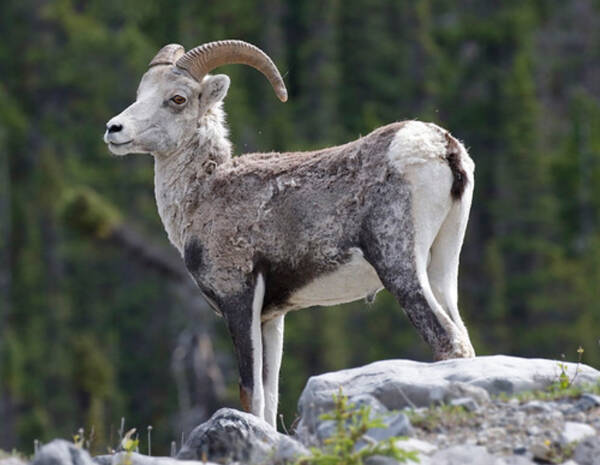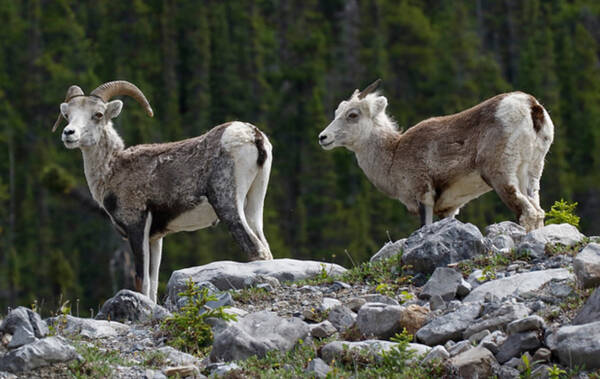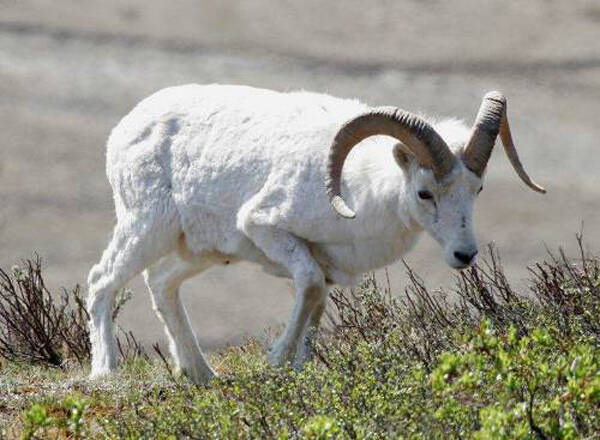Ovis dalli
IUCN
LCBasic Information
Scientific classification
- name:Ovis dalli
- Scientific Name:Ovis dalli, Thinhorn Sheep,Dall's Sheep,Stone’s sheep,Muflón de Dall
- Outline:Ungulata
- Family:Artiodactyla Bovidae Argali
Vital signs
- length:130-180cm
- Weight:46-113kg
- lifetime:10-15years
Feature
It is the only slender-horned goat in the genus Argali.
Distribution and Habitat
The species is found in the United States, including Alaska, through the Yukon and Northwest Territories of Canada, and into northern British Columbia.
The Dawes prefer a wide range of habitats in the Arctic and subarctic regions, mainly in high mountains. Generally, they inhabit arid mountainous areas, selecting communities of subalpine grasslands and low shrubs, relying on steep, rugged cliffs and rocky exposures to provide escape from predators. Forage in nearby open meadows and pastures. In winter, the species prefers areas with light snow and strong winds that facilitate snow removal and expose forage. Most Dawes occupy different summer and winter pastures, although some are resident. Migration is related to snow depth, temperature, and plant phenology. Spends the winter in windblown areas with exposed forage for most of the year.
Appearance
Dai's argali are sexually dimorphic. Males are approximately 40% heavier than females and mature at 4 years of age and continue to grow 2 years later than females. Males weigh between 73-113 kg, while females weigh between 46-50 kg. Male body length also ranges from 1.3-1.8 meters, and female body length ranges from 1.32 to 1.62 meters. The tail length of males is between 70-115 mm, and that of females is between 70-90 mm.
This species is the only slender-horned goat in the genus Argali. The horns are prominent and sexually dimorphic. Their horns are amber and almost transparent. Females have elongated horns, while males have large, open and curled horns. The horns of both sexes grow every year, but, after the first 4-5 years, the growth of the male's horns increases significantly and can eventually account for 8-10% of his total body weight. Horns grow in spring, summer and early fall, gradually slowing down. Horn growth ceases in winter. This pattern of starting and stop
Details
Dall's argali (scientific name: Ovis dalli) English Thinhorn Sheep, Dall's Sheep, Stone's sheep, Spanish Muflón de Dall, there are 2 subspecies.

Dall's argali has a complete social system. Ewes live with other ewes, lambs, yearlings and immature rams. Lambs mature early and actively play in the group. Sometimes creches are formed, where one or two ewes look after a group of lambs while another feeds them. Aggressive interactions between adult females are rare, but do occur, especially in cases of conflict over food or supplies. Older ewes usually win such confrontations because they have larger horns. Occasionally, collisions occur, but not horn clashes, such as between rams.
Adult Dai's argali rams live in single groups and do not associate with ewes until the mating season in late November and early December. Rams establish a dominance hierarchy during the summer, with the rank determined by horn size. This ranking is not only for access to females, as there are no females in the summer range, but also for social order. The established status allows the rams to live close to each other in an orderly society with little physical harm. Males gather together and begin their interactions by kicking each other with their front legs, displaying their horns, and sometimes jumping to threaten and clash. Dominance can also change, with subordinate males sometimes establishing dominance through friction rather than fighting. When males from different groups meet, dominance is established through fighting if the horns are of similar size. These fights are often thunderous, with the two males retreating 10 or 12 meters before rushing together and butting heads, with the sound of the collision being heard a kilometer away. Usually little damage is done, and after a few fights, the rams will casually separate.
Dai's argali are herbivores, eating mainly grasses and sedges. They live in a variety of habitats with many potential forage species. They can eat 50-120 plant species. Food is abundant in the summer, with a wide variety of plant species eaten. In the winter, food is much more limited, but 10-15 species are eaten in a year. They will select available grasses, sedges and forbs, but will also ingest lichens and mosses in small quantities, with wheatgrass, fescue, bluegrass and sedge being important foods, while clover, peas, lupine, sage, dwarf willow and clover are eaten when available.

In winter, the diet of the Dai's argali is influenced by the snow cover of the mountains and consists mainly of dry, frozen grasses and windblown sedge stems, as well as more lichens and mosses than in other seasons. Mineral licks of calcium phosphate or calcium-magnesium concentrates are also important in the diet, especially in spring and summer, to compensate for mineral deficiencies.
Dai's argali are gregarious animals with a polygynous mating system in which dominant males reproduce most often. As the estrus period approaches, males interact with females regularly, interactions between males become more active, and struggles for dominance occur. Larger rams usually win the fights, and dominance hierarchy influences breeding opportunities. These fights include aggressive sideways displays, powerful kicks, leaping threats, and wrestling. Male interactions during estrus can become violent. Some males even push rivals off cliffs.
Males approach females in a low-stretched posture while flicking their tongues to court them. Males can determine the estrus status of females by licking urine from the perianal area of females, which they lick from the ground while urinating, or after urinating. Males kick females with their front legs during courtship to assess their willingness to mate. If a female is in estrus, males will continue to court her and protect her from other males. Females can initiate courtship by bumping and rubbing against males. Mating occurs when a receptive female sits instead of walking forward. Males will guard females they mate with for 2-3 days, which can be the length of the estrus period. Males then stop guarding and look for other mates. As the estrus period ends, males become more solitary and less aggressive toward each other. As the more dominant males move on, younger males will attempt to woo females, but females are rarely receptive.

The gestation period of female Dai's argali lasts about 175 days, with one lamb born per litter, and twins are rare. Lambs weigh between 3-4 kg at birth. The ewes will lick and touch the lambs with their hooves soon after the lambs are born. Lambs can stand for the first time 15-32 minutes after birth and can walk with the ewes within 24 hours. Young lambs grow rapidly, reaching 27-30 grams at 9 months of age. Lambs are born in late May or early June. Lone ewes seek protection on the most rugged cliffs to give birth to their lambs safely. After giving birth, ewes will remain on the cliffs with their lambs until the lambs are strong enough to travel. Lambs begin to feed on plants within 2 weeks of birth and are weaned after 3-5 months, usually in October.
Rams reach sexual maturity at 18 months of age, but usually do not gain social dominance and adult size and mate successfully until 5-7 years of age. Females reach sexual maturity at 30 months and give birth to their first lamb at 3 or 4 years of age. Lambs are produced every year thereafter. In unhunted populations, annual growth rates can reach 11-18%, but in populations close to carrying capacity, mortality rates in the first winter of lambs can reach 40-50%.
The most recent global population update for the D. d'arguinea was published in 2010, which excludes the Yukon Territory in Canada. This assessment uses the estimate of Hoefs and Barichello (1985) for the Yukon Territory, assuming relatively stable populations. The total population of D. d'arguinea in Canada is 46,000–62,000 individuals. Of these, the nominate subspecies is 33,400–45,600 and the argali subspecies is 12,600–16,400. In 2000, the total population in the United States was estimated at 50,000–64,000. Therefore, the total population of D. d'arguinea is 96,000–126,000 individuals. Assuming that 60% of the population consists of mature individuals, there are 57,600–75,600 mature D. d'arguinea.
Listed in the IUCN Red List of Threatened Species in 2020 ver3.1 - Least Concern (LC).
Protect wild animals and eliminate game.
Maintaining ecological balance is everyone's responsibility!








